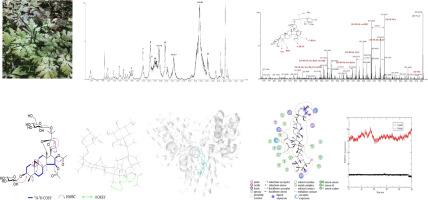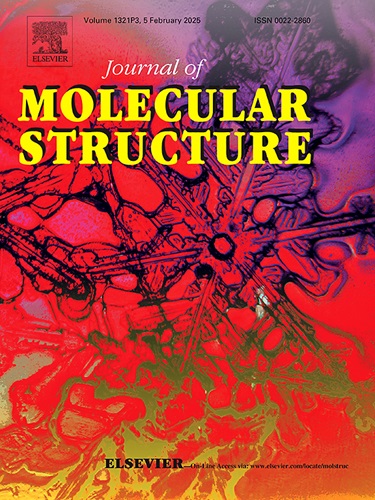Identification of anti-HIV cycloartane triterpenoids from Actaea vaginata using UPLC‐QTOF‐MS/MS, DFT calculations, docking, and molecular dynamics studies
IF 4.7
2区 化学
Q2 CHEMISTRY, PHYSICAL
引用次数: 0
Abstract
Structurally diverse triterpenoids have shown potential as pharmaceutical precursors for HIV treatment. Our previous research led to the discovery of a potent antiviral cycloartane triterpenoid derivative, (20S,24S)-15β,16β-diacetoxy-18,24;20,24-diepoxy-9,19-cyclolanostane-3β,25-diol 3-O-3′,3′-dimethyl succinate (DSC) derived from the triterpene glycoside beesioside I, exhibiting high-affinity interactions with the Capsid (CA) and spacer peptide 1 (SP1) domain (CA-SP1) region of the HIV Gag polyprotein. To discover new antiviral agents from natural resources, the methanolic extracts of Actaea vaginata were qualitatively analyzed using UPLC-QTOF-MS/MS. Based on characteristic ESIMS/MS fragmentations of cycloartane triterpenoids obtained from A. vaginata and relevant literature, twenty-one compounds including an unknown triterpenoid (1) were identified. Guided by LC-MS analysis, compound 1 was isolated and determined as (20S,24S)-15β,16β-diacetoxy-18,24;20,24-diepoxy-9,19-cyclanostane-3β,25-diol-3-O-β-d-xylopyranosyl-25-O-β-d-glucopyranoside by spectroscopic methods, showing moderate antiviral activity with an EC50 value of 8.6 µM against HIV-1NL-43 in MT4 cells. The structural data and electronic properties of compound 1 were determined using the B3LYP density functional method with the basis set 6–311+G(d,p). To further understand the compound's antiviral quality, molecular docking and molecular dynamics studies were conducted. The results indicated that compound 1 could be a potential candidate for anti-HIV treatment.

利用 UPLC-QTOF-MS/MS、DFT 计算、对接和分子动力学研究鉴定白花蛇舌草中的抗艾滋病毒环己烷三萜类化合物
结构多样的三萜类化合物已显示出作为治疗艾滋病药物前体的潜力。我们之前的研究发现了一种强效抗病毒环木菠萝烷三萜类衍生物,即 (20S,24S)-15β,16β-二乙酰氧基-18,24;20,24-二环氧-9,19-环羊毛甾烷-3β,25-二醇 3-O-3′,3′-二甲基丁二酸酯 (DSC),与 HIV Gag 多聚蛋白的帽状结构 (CA) 和间隔肽 1 (SP1) 结构域 (CA-SP1) 有高亲和力的相互作用。为了从天然资源中发现新的抗病毒药物,研究人员利用 UPLC-QTOF-MS/MS 对白花蛇舌草的甲醇提取物进行了定性分析。根据从苍术中提取的环木菠萝三萜类化合物的 ESIMS/MS 片段特征和相关文献,鉴定出 21 种化合物,其中包括一种未知的三萜类化合物(1)。在 LC-MS 分析的指导下,化合物 1 被分离出来,并通过光谱方法确定为 (20S,24S)-15β,16β-二乙酰氧基-18,24;20,24-二环氧-9,19-环木糖烷-3β,25-二醇-3-O-β-d-xylopyranosyl-25-O-β-d-glucopyranoside,在 MT4 细胞中对 HIV-1NL-43 的 EC50 值为 8.6 µM,显示出中等程度的抗病毒活性。化合物 1 的结构数据和电子特性是用基于 6-311+G(d,p) 的 B3LYP 密度泛函法确定的。为了进一步了解化合物的抗病毒特性,研究人员进行了分子对接和分子动力学研究。结果表明,化合物 1 有可能成为抗艾滋病毒治疗的候选化合物。
本文章由计算机程序翻译,如有差异,请以英文原文为准。
求助全文
约1分钟内获得全文
求助全文
来源期刊

Journal of Molecular Structure
化学-物理化学
CiteScore
7.10
自引率
15.80%
发文量
2384
审稿时长
45 days
期刊介绍:
The Journal of Molecular Structure is dedicated to the publication of full-length articles and review papers, providing important new structural information on all types of chemical species including:
• Stable and unstable molecules in all types of environments (vapour, molecular beam, liquid, solution, liquid crystal, solid state, matrix-isolated, surface-absorbed etc.)
• Chemical intermediates
• Molecules in excited states
• Biological molecules
• Polymers.
The methods used may include any combination of spectroscopic and non-spectroscopic techniques, for example:
• Infrared spectroscopy (mid, far, near)
• Raman spectroscopy and non-linear Raman methods (CARS, etc.)
• Electronic absorption spectroscopy
• Optical rotatory dispersion and circular dichroism
• Fluorescence and phosphorescence techniques
• Electron spectroscopies (PES, XPS), EXAFS, etc.
• Microwave spectroscopy
• Electron diffraction
• NMR and ESR spectroscopies
• Mössbauer spectroscopy
• X-ray crystallography
• Charge Density Analyses
• Computational Studies (supplementing experimental methods)
We encourage publications combining theoretical and experimental approaches. The structural insights gained by the studies should be correlated with the properties, activity and/ or reactivity of the molecule under investigation and the relevance of this molecule and its implications should be discussed.
 求助内容:
求助内容: 应助结果提醒方式:
应助结果提醒方式:


